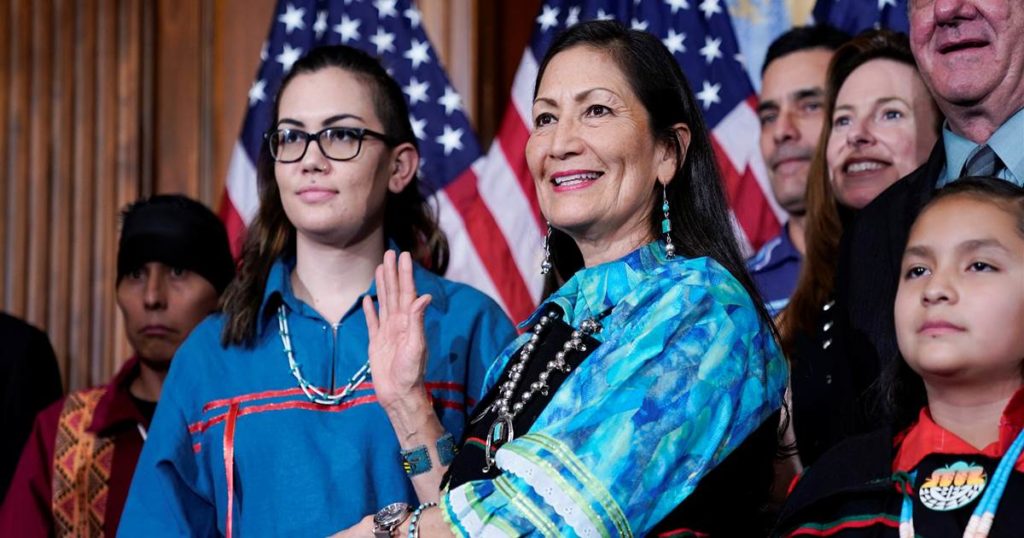Cultural Changes at Interior

Traditionally, the Department of Interior, which manages the Bureau of Indian Affairs and the public lands in the West where tribes have historical treaty claims, has not been great for Native Americans. That’s especially true under Republicans, but even for recent Democrats there was a lot more emphasis on traditional environmental protection than centering tribal needs. That has changed dramatically under Biden. Deb Haaland has been a remarkable Cabinet appointee and has demonstrated unequivocally that you can protect lands from development as a way to defend Native rights, especially if you put the tribes first. CAP has a good piece on her tenure at Interior.
After nearly four years of progressive leadership—some of which can be seen in her Instagram snapshots—Secretary Haaland has cemented her legacy by elevating the untold stories of American history, making groundbreaking progress to strengthen Tribal and Indigenous communities, and delivering historic conservation policies. Through overseeing record-setting investments, leading new co-stewardship agreements, issuing directives to include Indigenous traditional ecological knowledge, and following through on Tribal and Indigenous consultations, Secretary Haaland has done more than any of her predecessors to support Tribal nations and Indigenous communities’ stewardship of lands and waters.
Secretary Haaland has said “Native American history is American history,” and under her leadership, the Department of the Interior has taken great strides in telling the untold and hidden history of Tribal and Indigenous peoples in the United States.
For example, national parks have begun to reexamine the racist beliefs of John Muir, who is often called the “father of the national parks,” and National Park Service (NPS) employees have changed park signage to reflect previously untold histories of racism and genocide. Secretary Haaland even launched a theme study at the NPS collaborating with Tribes across the country to focus on the Indian Reorganization Period (1934–1950) to help broaden the understanding of an important chapter in American history and its context within modern public land management.
Secretary Haaland also established the Missing & Murdered Unit with the Bureau of Indian Affairs to ensure cross-departmental and interagency work pursuing justice in the epidemic of missing and murdered American Indians and Alaska Natives. Additionally, she established the Federal Indian Boarding School Initiative to investigate the history of American Indian boarding schools. And to further seek justice and tell these underrepresented stories, Secretary Haaland launched the “Road to Healing” tour, a years-long effort to travel across the country in order to give Indigenous survivors of the federal Indian boarding school system the opportunity to share their stories and be connected with trauma-informed support.
Finally, Secretary Haaland signed Secretary’s Order 3404 establishing a Derogatory Geographic Names Task Force, which reviewed 660 geographic features containing a particularly offensive ethnic, racial, and sexist slur and made recommendations for replacement names. She also signed Secretary’s Order 3405 establishing a Federal Advisory Committee to address other derogatory geographic names across the federal government.
And lets one think that this is some kind of woke attack on Interior’s mission, the core mission for Democrats at the agency very much fits into this framework.
In 2023 alone, the Department of the Interior protected more than 12.5 million acres of public lands as national monuments, mineral withdrawals, wildlife refuges, and more—safeguarding nearly the same amount of lands in 2023 as during the administration’s first two years. Combined, all these areas would be about the size of Virginia. Notably, Secretary Haaland has also led actions to protect sacred spaces from industrial harm, including by withdrawing the public lands surrounding Chaco Culture National Historical Park from future mining and leasing claims—which she advocated for as a member of the U.S. House of Representatives and delivered as secretary—and by supporting designation of the Baaj Nwaavjo I’tah Kukveni – Ancestral Footprints of the Grand Canyon National Monument in Arizona.
Secretary Haaland has also overseen a long-overdue overhaul of the management of 250 million acres of public lands, turning the page on decades of mismanagement and conflict over Bureau of Land Management (BLM) lands. Anchored by the Public Lands Rule, a suite of recently completed actions will ensure public lands are wisely stewarded for future generations while remedying major problems from oil and gas development, accelerating responsible clean energy development, and supporting outdoor recreation and other community needs. Additionally, the BLM recently secured protections for more than 13 million acres in the Western Arctic—an area especially vulnerable to expanded oil and gas development and the most visible impacts of climate change.
Secretary Haaland has made historic investments in Indian Country, channeling more conservation investments to Tribal communities than any other interior secretary. This includes $580 million toward Indian water rights settlements to continue to safeguard clean water resources for Tribal communities using funding from President Joe Biden’s Bipartisan Infrastructure Law and the Reclamation Water Settlements Fund, a $135 million commitment to support relocation of Tribal communities affected by climate change, and $15 million for the Indian Youth Service Corps to support programs that develop the next generation of conservation and climate stewards.
This is all fantastic work. Of course no Cabinet secretary can do this alone. It takes support from the president and from Congress and sometimes from other Cabinet secretaries, which sometimes doesn’t happen. So there’s plenty of credit to go around. But no one deserves more than Haaland. She’s clearly among the best if not the very best of the Biden Cabinet appointees.
And just as a point of comparison, easily the worst Biden Cabinet appointee is Merrick Garland.


